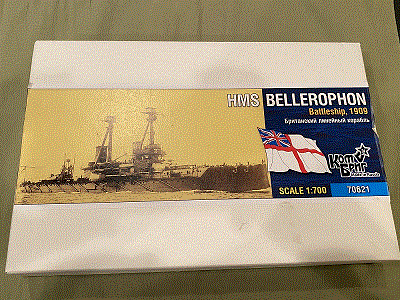Reviewed December
2020
by Christopher Martens
|
| HISTORY |
|
| HMS Bellerophon was the first of Britain's follow ups to
their revolutionary HMS Dreadnought and were essentially repeats of the
earlier vessel. The Bellerophons were slightly larger, had slightly better
protection, and had a better secondary armament. Completed in 1909, joining
the Nore, later First, Division of the Home Fleet. She participated in
fleet manoveurs in 1910, being observed by the ill-fated Tsar Nicholas
II. Mid-year, the entered the first of many refits. Immediately after,
she collided with the HMS Inflexible, the first of many occasions the battleship
would have an all too close encounter
Prior to the outbreak of the Great War, Bellerophon joined the 4th Battle
Squadron as newer dreadnought-type battleships came into service. She participated
in a test mobilization as part of a response to the July Crisis, soon after
enduring another collision, this time with the SS St Clair. Bellerophon
participated in several fruitless sweeps of the North Sea, constantly playing
cat and mouse with German fleet elements, or phantasms thereof. The battleship
took part in the Battle of Jutland, crippling the SMS Wiesbaden and possibly
engaging German dreadnoughts and one battlecruiser during the battle. By
the end of the war, the vessel underwent substantial changes, including
a far more substantial superstructure.
Combrig's kit presents the ship as she was completed, in 1909. |
| THE HULL |
|
| As with many of Combrig's newest kits, Bellerophon's hull
is a symphony of detail. Hatches, supports, and ventilation hatches cover
the hull. Molding is sharp, straight, and matches plans I have on hand. |
|
|
| SUPERSTRUCTURE,
CONNING TOWER, AND FUNNELS |
|
| As with any Combrig kit, superstructure
parts are present on a thin wafer. Superstructure detail is crisp and plentiful.
My only issue with the kit is in the last photo of this series: her
superstructure doesn't quite line up. Good news is that this can be remedied
by shimming the deck forward, just aft of the forward turret. I contacted
the owner of Combrig before writing this review and want to express my
admiration for how seriously and easily he took the little bit of criticism. |
|
|
| MISCELLANEOUS
PARTS |
|
| Combrig includes a myraid
of small resin parts for everything from paravines to anchors. These parts
are presented on Combrig's usual strip wafers. I'm particularly shocked
with the quality of the winches. Detail is incredible, on par with many
modern resin and 3D printed options. |
|
|
| ARMAMENT |
|
| The 12 turrets are extremely well-molded and even the barrels
are usable and hollow-tipped, unusual in resin. Unfortunately, several
of the 4" guns had broken free of their wafer. Thankfully, enough remain
for the build. |
|
|
| SHIP'S BOATS |
|
| The ships' boats are, by far, the best options Combrig
has offered with their kits. Again, these are on par with many cutting
edge offerings from well-respected aftermarket options. |
|
|
|
|
| |
| PHOTOETCH |
|
| Combrig's comprehensive photo etch set contains everything
that is needed to complete this vessel. There is minimal relief etching,
but what's offered is very good. |
|
|
| INSTRUCTIONS |
|
| Photos below are snapshots from Combrig's instruction manual.
Instructions are intuitive, clear, and also offer in-scale sizing brass
stock needed for masts and some crane booms. Full instructions can be found
at: HMS
Bellerophon's Instructions, 1909 |
|
|
|
|
|
|
| CONCLUSIONS |
|

Combrig continues to tackle less known Great War
subjects and do them quite well. These new kits are true multimedia kits,
though often missing masts and other brass stock scratched items. I'm continually
impressed with Combrig's careful attention to details. Bellerophon retails
for approximately $80 which is in my humble opinion, a steal, even including
some of the small issues I've highlighted.
Thank you to Combrig
for this review sample. I will thoroughly enjoy building it. |



